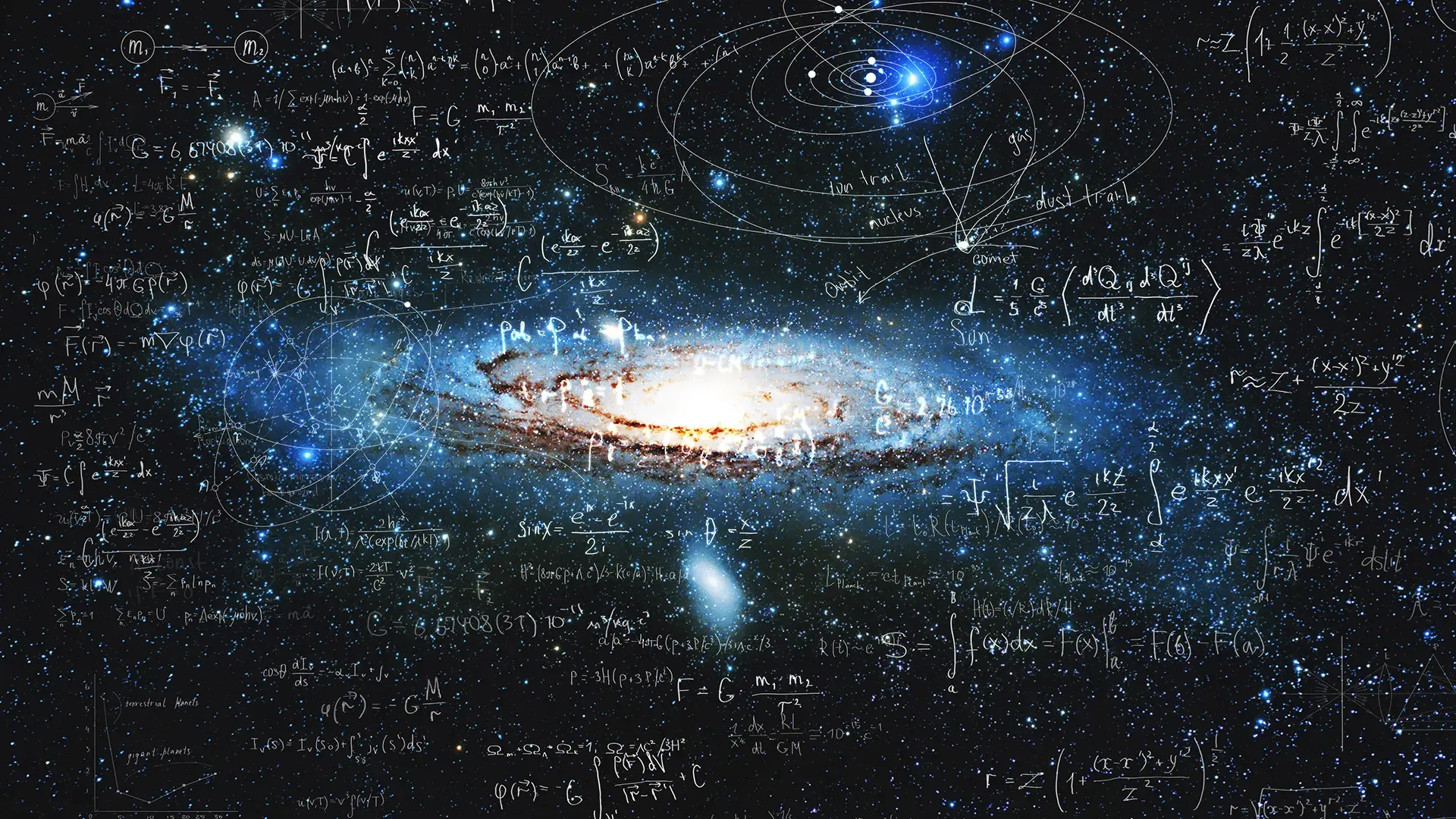The Big Bang From a Biblical Perspective

“If there is no God, why is there something rather than nothing?” The late Christian apologist Dr. Norman Geisler posed this question to an atheist in a debate at the University of Miami. Academic debaters typically focus on swaying the audience to their side but this atheist publicly admitted, “That is a really good question.”
If the universe and life had a beginning, something or someone must have caused that beginning. Is the universe eternal? Are space, time and matter eternal? If the universe and life had a beginning, how did it begin? Was it purely natural causes or an intelligent being who purposefully began it all?
During the 20th century, several leading scientists grappled with these questions. Charles Darwin’s theory of evolution made the theistic God theoretically unnecessary for the first time, or so some scientists thought. Darwinian evolution gave rise to the theory that the universe and life were eternal.
As scientists explored the universe and life further, cracks appeared in their static, eternal universe theories. World-famous scientist Albert Einstein published his theory of General Relativity in 1915. He considered his discovery “irritating” since it led him away from his belief in a static universe and demanded a beginning.
His theory of General Relativity revealed that space, time and matter are inseparably linked – one cannot exist without the others. It demanded an absolute beginning for all three, which flew in the face of the popular theories of an eternal and static universe. Einstein’s findings pointed him to the necessary conclusion that there must have been a beginning and therefore a beginner – some being or force who brought space, time and matter into existence simultaneously.
Instead of being intellectually honest and going where the evidence led him, in 1917 Einstein introduced a “cosmological constant” into his theory of General Relativity so that he could maintain his belief in a static and eternal universe and thus deny the need for a beginning and a beginner.
It did not take long for his error to be discovered. In 1919, British cosmologist Arthur Eddington confirmed the validity of General Relativity through an experiment during a solar eclipse. In 1922, Russian physicist Alexander Friedmann revealed Einstein’s mathematical error in inserting his cosmological constant. Scientific evidence began to point to the need for a beginning and a beginner.
During this time, Edwin Hubble began his work at the Mount Wilson Observatory just outside of Los Angeles, California. He used the newly built 100-inch Hooker telescope to make discoveries that challenged the static and eternal universe theory and changed astronomy forever.
The prevailing theory at this time was that the universe was limited to the Milky Way Galaxy. Hubble discovered entire galaxies beyond the Milky Way. As he made this ground-breaking discovery, he also observed a “redshift” as these galaxies moved away from the Milky Way, which further validated Einstein’s theory of General Relativity. Simply stated, a redshift is the light an object in space leaves behind as it moves away from us.
Einstein visited Mount Wilson to observe these things for himself in 1929. He could no longer ignore the evidence he saw with his own eyes nor could he remain intellectually dishonest. He observed the expanding universe for himself as his theory of General Relativity predicted. Einstein later admitted that the addition of his cosmological constant was the “greatest blunder” of his life.
As the years rolled on, further scientific data continued to verify the universe had a beginning and therefore, a beginner. For example, The Second Law of Thermodynamics states the amount of usable energy in the universe is decreasing. There would be no energy left today if there was no beginning point.
In the 1960s, scientists Arno Penzias and Robert Wilson discovered cosmic microwave radiation and received the Nobel Prize in physics in 1978 for their efforts. They theorized that if there had been a massive explosion, a big bang, then they should be able to detect energy related to that event. Through the use of precise instruments, their team was able to detect the kind of radiation they anticipated. They considered it to be like a signature of the beginning of the universe and life.
Other scientists built upon the discoveries of Penzias and Wilson and discovered precise temperature variations, or ripples, in cosmic microwave radiation. This discovery revealed that the beginning of the universe did not happen randomly, as one would expect with an energy fireball explosion; rather, it occurred precisely as if someone was controlling the beginning and expansion of the universe. If Penzias and Wilson discovered the signature of the beginning, the discovery of these ripples is like looking at the fingerprints of the maker.
Returning to Einstein’s day, in 1927, Belgian astrophysicist and Catholic priest Georges Lemaître combined Einstein’s theory of General Relativity with Hubble’s astronomical observations to demonstrate the universe is expanding. He theorized that if space, time and matter are simultaneously expanding, they must have begun at a single starting point. Lemaître developed these observations into a theory that stated the universe began with an explosion of what he called a “primeval atom.” This theory is better known today as the Big Bang theory.
Lemaître made little attempt to correlate his findings with Christian theology. He was alarmed when Pope Pius XII considered this scientific discovery as validation of the Catholic faith. Lemaître argued atheists could as easily accept his Big Bang theory as theists.
However, this forces one to consider the opening question – if there is no God, why is there something rather than nothing? If time, space and matter are inseparable, if mountains of scientific evidence point to the fingerprints of a maker, and if the expansion of the universe reveals that it all must have started at the same cataclysmic moment, then it begs the question – “Where did this ‘primeval atom’ come from?”
This creates a problem of infinite regress for atheists. One could simply keep asking the question, “Where did that come from?” For example, Lemaître thought the primeval atom contained powerful energy that exploded into what became the universe and life. Where did that energy come from? How did it come into existence?
This line of arguing sounds like a small child asking for the hundredth time from the backseat of the car, “Are we there yet?” The driver will eventually be able to answer, “Yes!” to that seemingly annoying question. Similarly, the atheist might get annoyed by having to repeatedly answer endless “Where did that come from?” questions, but this question demands an answer. They must arrive at a destination.
How did nothing bring something into existence? Dr. Norman Geisler wrote in his classic book, I Don’t Have Enough Faith to Be an Atheist, “And in light of the evidence, we are left with only two options: either no one created something out of nothing, or else someone created something out of nothing. Which view is more reasonable? Nothing created something? No.”
The scientific evidence screams, “Beginning!” The Law of Causality shouts, “There must be a cause!” There must be some force or being who brought space, time and matter into existence. Does this scientific evidence reveal any characteristics of this being?
What Kind of “Beginner”?
The atheistic viewpoint is badly wounded by the brutal gang of facts revealed in the last section. Just as Julie Andrews sang in “The Sound of Music,” “Nothing comes from nothing, nothing ever could.” Non-life has never created life. Non-being has never created being. These are logical and scientific impossibilities. It took Einstein a few years, but ultimately, he could no longer hide behind theories that increasingly were proven incorrect. He admitted his error and agreed that the universe and life must have had a beginning.
Pantheism teaches that god is the universe. How could a being that is part of this time, space, and matter universe create it? Does not the scientific evidence point to a being who is outside of time, space and matter who began it? Yes, it certainly does.
Furthermore, the evidence points to a highly intelligent cause since the universe and life have such a high degree of complexity. Modern science reveals highly crafted and precisely tuned designs down to the microscopic level. Inside every living cell are complex organisms that require design and purpose. Earth’s ecosystems work together harmoniously to allow the kinds of complex life no other planet enjoys.
To say all this arose by random chance and time is akin to claiming the evolution of the airplane happened when the Wright brothers abandoned their plane in Kitty Hawk, North Carolina, then 100 years later someone stumbled upon a shiny new fighter jet in its place that evolved by random chance and time without any intelligent intervention whatsoever. When one speaks about the evolution of the airplane, common sense reveals that it took intelligent beings to design, build and fly these airplanes.
Not only does the evidence reveal a highly intelligent cause of the beginning of the universe and life, but it also reveals that an extremely powerful being must have begun it. The largest star discovered to date is called UY Scuti. It is about 1,700 times larger than the sun.
Space.com states that almost 5 billion suns could fit inside of UY Scuti. Over a million Earths can fit inside the sun. One million times 5 billion equals 5,000,000,000,000,000, which means that 5 quadrillion Earths would fit inside this one star! The beginner of all that exists must have massive power and vast capabilities far beyond anything humans can muster.
A supremely powerful and intelligent being who is outside space, time and matter certainly lines up with the theistic worldview. Other fields of study and lines of evidence are necessary to help further identify the beginner of the universe and life. The surface has barely been scratched in this article. However, this scientific evidence makes it plain for all to see. The universe and life had a beginning and, therefore, a beginner who is an awesome architect, divine designer, excellent engineer, precise planner, immensely intelligent and preeminently powerful.




Leave a Reply